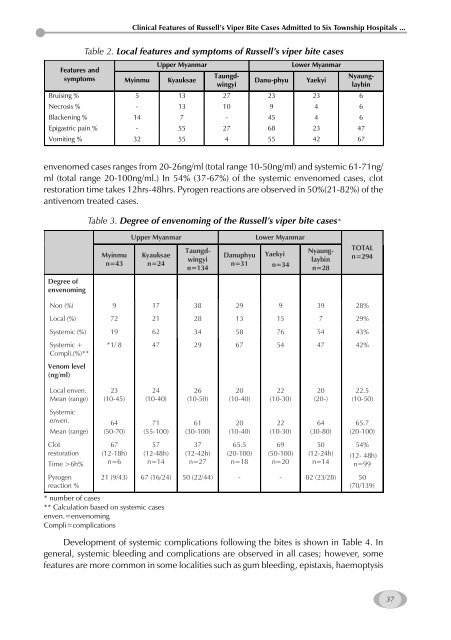Management of Snakebite and Research Management of Snakebite ...
Management of Snakebite and Research Management of Snakebite ...
Management of Snakebite and Research Management of Snakebite ...
You also want an ePaper? Increase the reach of your titles
YUMPU automatically turns print PDFs into web optimized ePapers that Google loves.
Features <strong>and</strong><br />
symptoms Myinmu Kyauksae<br />
Clinical Features <strong>of</strong> Russell’s Viper Bite Cases Admitted to Six Township Hospitals ...<br />
Table 2. Local features <strong>and</strong> symptoms <strong>of</strong> Russell’s viper bite cases<br />
Upper Myanmar Lower Myanmar<br />
Taungdwingyi<br />
Danu-phyu Yaekyi<br />
Nyaunglaybin<br />
Bruising % 5 13 27 23 23 6<br />
Necrosis % - 13 10 9 4 6<br />
Blackening % 14 7 - 45 4 6<br />
Epigastric pain % - 55 27 68 23 47<br />
Vomiting % 32 55 4 55 42 67<br />
envenomed cases ranges from 20-26ng/ml (total range 10-50ng/ml) <strong>and</strong> systemic 61-71ng/<br />
ml (total range 20-100ng/ml.) In 54% (37-67%) <strong>of</strong> the systemic envenomed cases, clot<br />
restoration time takes 12hrs-48hrs. Pyrogen reactions are observed in 50%(21-82%) <strong>of</strong> the<br />
antivenom treated cases.<br />
Degree <strong>of</strong><br />
envenoming<br />
Table 3. Degree <strong>of</strong> envenoming <strong>of</strong> the Russell’s viper bite cases*<br />
Myinmu<br />
n=43<br />
Upper Myanmar Lower Myanmar<br />
Kyauksae<br />
n=24<br />
Taungdwingyi<br />
n=134<br />
Danuphyu<br />
n=31<br />
Yaekyi<br />
n=34<br />
Nyaunglaybin<br />
n=28<br />
TOTAL<br />
n=294<br />
Non (%) 9 17 38 29 9 39 28%<br />
Local (%) 72 21 28 13 15 7 29%<br />
Systemic (%) 19 62 34 58 76 54 43%<br />
Systemic +<br />
Compli.(%)**<br />
Venom level<br />
(ng/ml)<br />
Local enven.<br />
Mean (range)<br />
Systemic<br />
enven.<br />
Mean (range)<br />
Clot<br />
restoration<br />
Time >6h%<br />
Pyrogen<br />
reaction %<br />
*1/ 8 47 29 67 54 47 42%<br />
23<br />
(10-45)<br />
64<br />
(50-70)<br />
67<br />
(12-18h)<br />
n=6<br />
24<br />
(10-40)<br />
71<br />
(55-100)<br />
57<br />
(12-48h)<br />
n=14<br />
26<br />
(10-50)<br />
61<br />
(30-100)<br />
37<br />
(12-42h)<br />
n=27<br />
20<br />
(10-40)<br />
20<br />
(10-40)<br />
65.5<br />
(20-100)<br />
n=18<br />
22<br />
(10-30)<br />
22<br />
(10-30)<br />
69<br />
(50-100)<br />
n=20<br />
20<br />
(20-)<br />
64<br />
(30-80)<br />
50<br />
(12-24h)<br />
n=14<br />
22.5<br />
(10-50)<br />
65.7<br />
(20-100)<br />
54%<br />
(12- 48h)<br />
n=99<br />
21 (9/43) 67 (16/24) 50 (22/44) - - 82 (23/28) 50<br />
(70/139)<br />
* number <strong>of</strong> cases<br />
** Calculation based on systemic cases<br />
enven.=envenoming<br />
Compli=complications<br />
Development <strong>of</strong> systemic complications following the bites is shown in Table 4. In<br />
general, systemic bleeding <strong>and</strong> complications are observed in all cases; however, some<br />
features are more common in some localities such as gum bleeding, epistaxis, haemoptysis<br />
37









